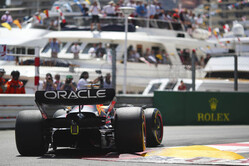 F1 exhausts are a critical component of Formula One racing cars.
F1 exhausts are a critical component of Formula One racing cars.
They're responsible for directing the exhaust gases away from the engine and allowing for the efficient expulsion of these gases. It's an essential function for F1 cars, enabling the engine to operate at its maximum power output, giving the vehicle a significant performance boost on the track.
By understanding how F1 exhausts work and their impact on car performance, fans of the sport can gain a deeper appreciation for the technology and engineering that goes into building these high-performance vehicles.
You may find more information about F1 exhausts in the sport by reading on. If you're interested in F1 in general, you may also be interested in articles on the topic by Josh Lester.
The Design And Function Of F1 Exhausts
F1 exhausts are carefully designed and constructed to enhance the performance of an F1 car. They're typically made from high-grade titanium or Inconel, a nickel-chromium alloy known for its heat resistance and durability. The exhaust system consists of a series of pipes that run from the engine to the car's rear, where the exhaust gases are expelled.
The design of F1 exhausts plays a crucial role in the overall performance of an F1 car. The exhaust gases produced by the engine contain a significant amount of energy, and carefully directing these gases can boost the car's acceleration and speed. In addition, the design of the exhaust system can affect the vehicle's aerodynamics, which can further improve its performance.
 F1 exhausts also play a vital role in the sound of an F1 car. The exhaust note of an F1 car is iconic and considered an integral part of the overall racing experience. The design of the exhaust system can affect the tone and volume of the car's exhaust note, which can be a critical factor in the car's appeal to F1 racing fans.
F1 exhausts also play a vital role in the sound of an F1 car. The exhaust note of an F1 car is iconic and considered an integral part of the overall racing experience. The design of the exhaust system can affect the tone and volume of the car's exhaust note, which can be a critical factor in the car's appeal to F1 racing fans.
The Evolution Of F1 Exhausts
F1 exhausts have come a long way since the sport's early days. Initially, the exhausts were a simple affair, with a single pipe extending out the back of the car. Over time, however, engineers have worked to improve the design of F1 exhausts to extract more performance from the vehicle.
One of the critical milestones in the evolution of F1 exhausts came in the 1980s when teams began to experiment with twin exhausts. By splitting the exhaust gases into two streams, engineers were able to create more downforce, which improved the car's handling and stability.
Another significant development came in the late 1990s when teams began to use so-called 'blown diffusers'. By routing the exhaust gases through the diffuser, teams were able to create additional downforce, which helped improve the car's grip and handling.
More recently, teams have been experimenting with exhaust-blown diffusers, which use exhaust gases to enhance the car's aerodynamics. In addition, teams have been using exhaust-mounted sensors to gather data on the car's performance.
 The Regulations Governing F1 Exhausts
The Regulations Governing F1 Exhausts
The current regulations governing F1 exhausts dictate that they must be located within a specified area at the car's rear. They must exit within a specific zone that's defined by the bodywork. These regulations were implemented to ensure that all vehicles have a similar aerodynamic profile and limit the amount of downforce generated by exhaust gases.
These regulations significantly impact the design and function of F1 exhausts. The limited space available for the exhausts means that teams must carefully design them to maximize performance within the constraints of the rules. Furthermore, the restrictions on where the exhaust gases can exit the car limit the amount of downforce that teams can generate using their exhausts.
These restrictions have led to a greater emphasis on other aerodynamic components, such as the diffuser, to generate downforce.
The Impact Of F1 Exhausts On the Environment
F1 exhausts have long been a concern for environmentalists due to their potential impact on air and noise pollution. The high-powered engines in F1 racing produce significant emissions, which can contribute to air pollution and health problems for those living near F1 tracks.
In recent years, F1 teams have tried reducing the environmental impact of their exhaust systems. One of the measures they have undertaken is using catalytic converters, which help to reduce the number of harmful emissions produced by the engines. These devices work by converting pollutants into less toxic substances, such as water and carbon dioxide, before they're released into the atmosphere.
Additionally, many F1 teams have also begun using noise-reducing exhaust systems. These systems use special mufflers and other design features to reduce the engine noise produced. The use of noise-reducing exhaust systems helps reduce the environmental impact of F1 racing and makes it more enjoyable for fans attending races in person.
While F1 exhausts still have some impact on the environment, teams are taking steps to reduce this impact and make the sport more sustainable.
Conclusion
The development of F1 exhaust systems is still ongoing. The aim is to maximize the power and sound of the exhaust note while minimizing backpressure. Keeping track of these developments is interesting, especially for F1 racing fans.























